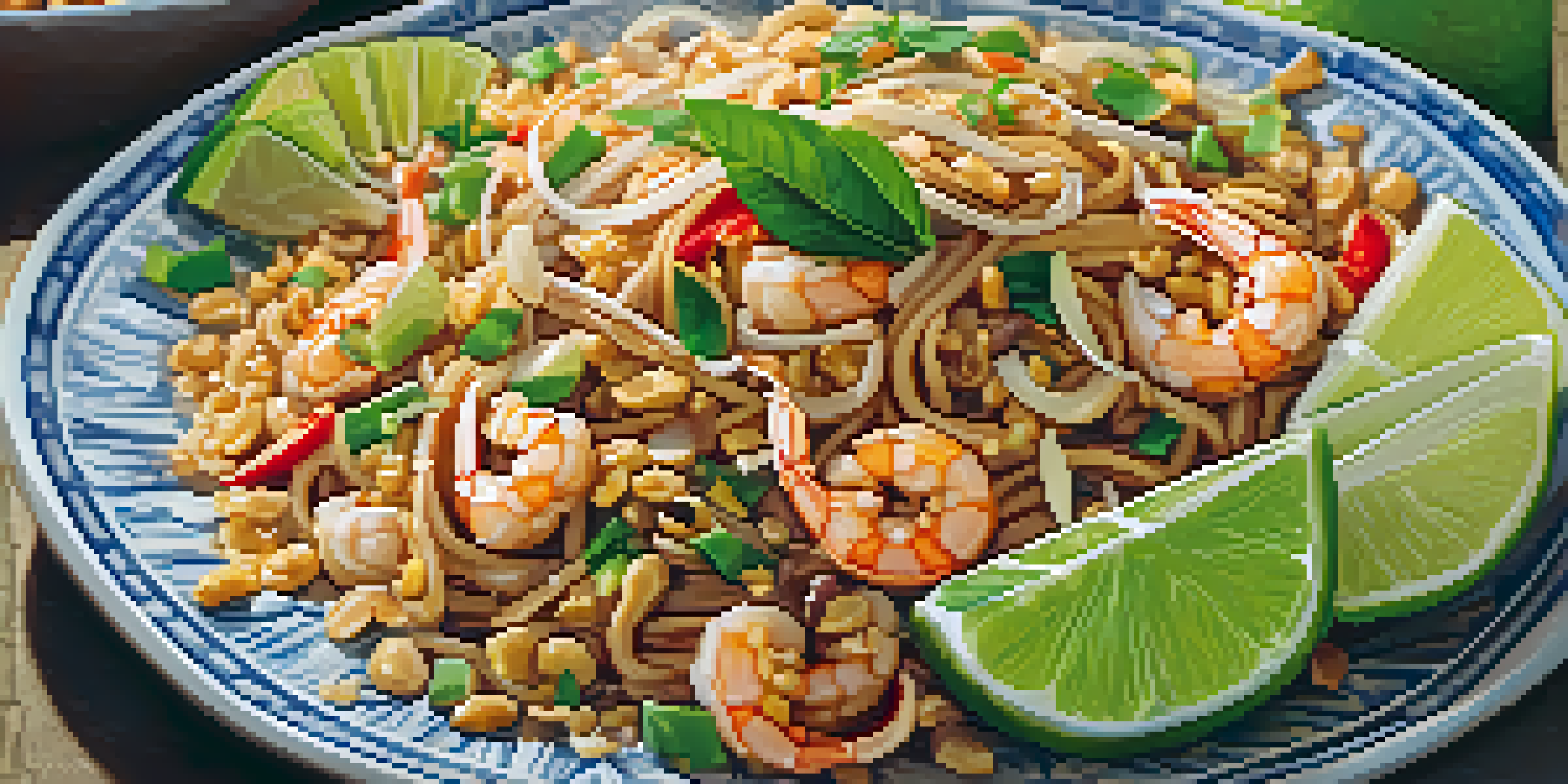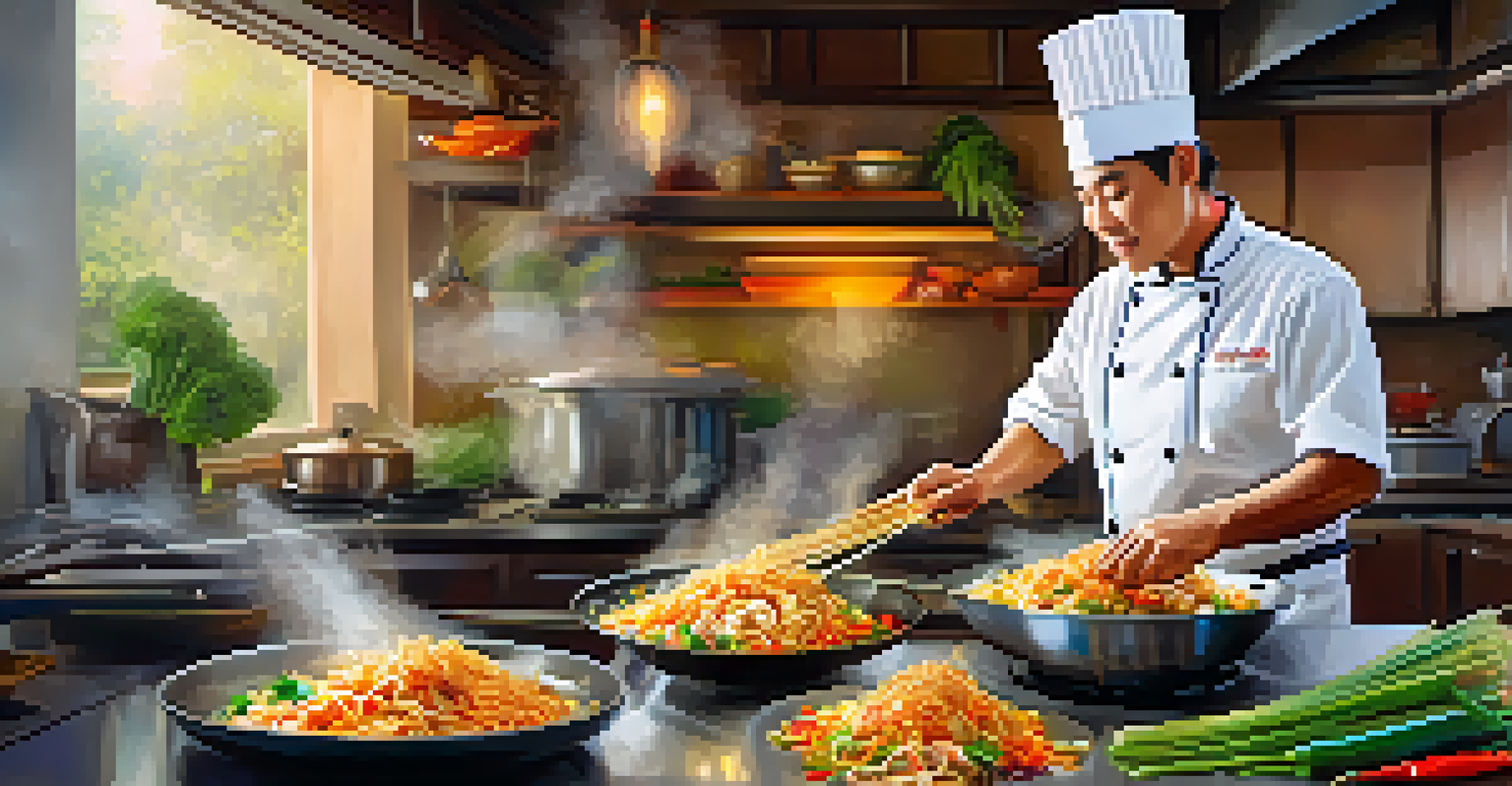Mastering Pad Thai: A Must in Thai Culinary Classes

The Origins and Cultural Significance of Pad Thai
Pad Thai is more than just a delicious dish; it’s a cultural icon in Thailand. Originating in the 1930s, it was part of a national campaign to promote rice noodles and reduce rice consumption. This dish quickly became a symbol of Thai identity and unity, reflecting the country's rich culinary heritage.
There is no love sincerer than the love of food.
As you explore Pad Thai, you're not just learning to cook; you're tapping into a story of resilience and adaptation. The blend of flavors and ingredients mirrors Thailand's diverse influences, from Chinese stir-fry techniques to local Thai tastes. Understanding its history adds depth to your culinary experience.
In Thai culinary classes, appreciating the origins of Pad Thai will enhance your cooking. It’s about respecting tradition while experimenting with flavors, making it a perfect starting point for any aspiring chef.
Essential Ingredients for Authentic Pad Thai
To create an authentic Pad Thai, you'll need a handful of key ingredients that come together to form its signature taste. Rice noodles, tamarind paste, fish sauce, and palm sugar are the backbone of this dish. Each ingredient contributes a unique flavor, making the final dish a harmonious balance of sweet, sour, and salty.

Don't forget the garnishes! Fresh bean sprouts, lime wedges, and crushed peanuts add texture and freshness, elevating your dish from good to unforgettable. Incorporating these elements is crucial in Thai culinary classes, as they teach you how to achieve that authentic street food vibe.
Pad Thai's Cultural Roots
Originating in the 1930s, Pad Thai symbolizes Thai identity and unity, showcasing the country's rich culinary heritage.
By mastering these ingredients, you can adapt Pad Thai to your taste preferences, whether that means adjusting the spice level or experimenting with proteins like shrimp, chicken, or tofu. This flexibility is part of what makes Pad Thai such a beloved dish worldwide.
Step-by-Step Guide to Cooking Pad Thai
Cooking Pad Thai is a process that requires both patience and practice. Start by soaking your rice noodles in warm water until they’re soft but still firm. This step is critical, as over-soaked noodles can lead to a mushy dish, which nobody wants!
Food is our common ground, a universal experience.
Next, stir-fry your proteins and vegetables in a hot wok to achieve that signature charred flavor. The high heat is essential for creating those delectable, crispy bits that make Pad Thai so irresistible. Timing is key here, as you want everything to come together perfectly.
Finally, toss in your soaked noodles with the sauce mixture, making sure every strand is coated with that delicious blend. This technique of tossing rather than stirring helps retain the noodle structure. With practice, you'll master the art of Pad Thai in no time!
Common Mistakes to Avoid When Making Pad Thai
Even seasoned chefs can make mistakes when preparing Pad Thai. One common pitfall is using the wrong type of noodles. Always opt for flat rice noodles, as using egg noodles or other varieties can alter the dish's authenticity and texture.
Another frequent error is skimping on the sauce. Pad Thai relies on a well-balanced sauce to deliver its signature flavor. If you don't use enough tamarind or fish sauce, the dish can taste bland, so don't hesitate to be generous with those ingredients!
Key Ingredients for Authenticity
Essential ingredients like rice noodles, tamarind paste, and fish sauce create the dish's signature balance of flavors.
Lastly, cooking at the right temperature is crucial. A wok needs to be hot to achieve that coveted smoky flavor and perfect noodle texture. If your wok isn’t hot enough, you risk ending up with soggy noodles instead of the delightful stir-fry experience you’re aiming for.
Variations of Pad Thai to Try at Home
While traditional Pad Thai is delicious on its own, there are countless variations to explore! Consider trying a vegetarian version by swapping out the proteins for tofu and adding extra vegetables like bell peppers and broccoli. This not only enhances the dish's nutritional value but also adds vibrant colors.
You might also experiment with different proteins, like grilled shrimp or a spicy chicken version, to cater to your taste. Each variation allows you to play with flavors and textures, making Pad Thai a versatile dish that suits any palate.
Don't forget to put your twist on the garnishes! Adding fresh herbs like cilantro or mint can introduce a refreshing twist that brightens the dish. These variations keep your culinary journey exciting and encourage creativity in the kitchen.
Pairing Drinks with Your Pad Thai
Finding the right drink to complement your Pad Thai can elevate your dining experience. A classic pairing is a chilled Thai beer, which balances out the rich flavors of the dish. The lightness of the beer helps cleanse the palate, making each bite of Pad Thai more enjoyable.
If you're looking for something non-alcoholic, consider pairing your meal with a refreshing iced Thai tea. The sweet and creamy notes of the tea can beautifully contrast the savory flavors of Pad Thai, creating a delightful harmony.
Common Cooking Mistakes to Avoid
Avoid using the wrong noodles and skimping on sauce, as these errors can lead to a bland or unauthentic Pad Thai.
Lastly, for those who enjoy wine, a crisp Riesling or Sauvignon Blanc can work wonders. Their acidity cuts through the richness of the dish, enhancing the overall flavor profile. Experimenting with different beverages can lead to delicious discoveries!
Conclusion: Embrace the Art of Pad Thai in Culinary Classes
Mastering Pad Thai is not just about perfecting a recipe; it’s about embracing the rich culture and tradition behind it. By learning this dish in culinary classes, you gain invaluable skills that extend beyond the kitchen.
As you practice, remember that cooking is a journey filled with experimentation and learning. Each time you prepare Pad Thai, you’ll refine your technique and deepen your appreciation for this iconic dish.

So, roll up your sleeves, gather your ingredients, and dive into the flavorful world of Pad Thai. With each stir-fry, you’re not just cooking; you’re creating a piece of culinary art that connects you to Thailand’s vibrant culture.